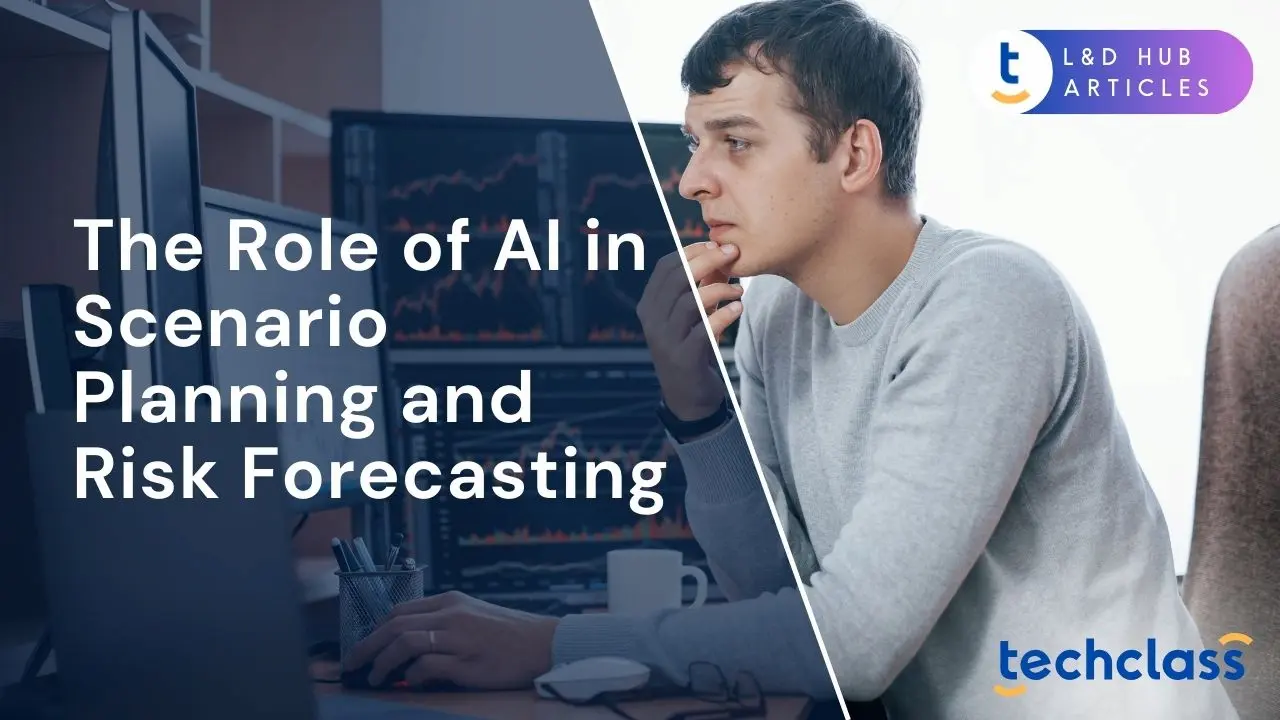
In an era of rapid change and uncertainty, businesses are under pressure to anticipate future challenges before they arise. Global events like climate change, geopolitical conflicts, and technological disruptions can upend even the best-laid plans overnight. To stay resilient, organizations have long relied on scenario planning, crafting plausible future scenarios to test strategies, and risk forecasting, predicting potential risks and opportunities. However, traditional approaches to these practices have limits. Humans can only identify so many trends and imagine a handful of scenarios, often missing subtle signals in the data. This is where artificial intelligence (AI) steps in as a game-changer. AI’s ability to sift through vast datasets, learn patterns, and simulate outcomes is transforming how companies plan for the future. In fact, a recent industry survey found that the top uses of AI among risk professionals include risk forecasting (30% of respondents), risk assessment (29%), and scenario planning simulations (27%), clear evidence that AI is already augmenting how organizations prepare for what lies ahead.
Enterprise leaders and HR professionals across industries are increasingly curious about the role of AI in scenario planning and risk forecasting. This article will explore how AI enhances these critical strategic activities. We’ll break down the basics of scenario planning and risk forecasting, examine the ways AI improves them (from generating diverse “what-if” scenarios to providing early warnings of emerging risks), and look at real-world examples spanning supply chains, finance, HR, and more. We’ll also discuss the benefits organizations can reap, as well as the challenges and ethical considerations to keep in mind, when integrating AI into their planning and risk management processes.
Scenario planning is a strategic process of envisioning and analyzing multiple plausible future situations. Rather than predicting one definitive outcome, scenario planning asks “What might happen?” under different sets of assumptions (for example, a best-case, worst-case, and baseline scenario for a market or policy change). Business leaders use these scenarios to test how their strategies would hold up if conditions change, such as if a new competitor emerges, a regulation shifts, or an economic downturn strikes. The goal is to improve preparedness and flexibility: by considering a range of futures, organizations can develop contingency plans and “anticipate and address…uncertainties” more effectively. Scenario planning has traditionally been a qualitative, human-driven exercise, often involving workshops and brainstorming by experts. While valuable, it is inherently limited by human imagination and cognitive bandwidth, people can deeply analyze only a few scenarios at a time, and may overlook complex interactions between factors.
Risk forecasting, on the other hand, focuses on predicting specific risks or events and their likelihood. It is a key part of risk management and often relies on quantitative analysis. For example, a financial institution might forecast the probability of loan defaults in its portfolio, or an HR team might estimate the risk of a surge in employee turnover next year. Risk forecasting uses historical data, statistical models, and expert judgment to estimate the probability and impact of adverse events (or even positive opportunities). Traditional risk forecasting methods include techniques like trend analysis and stress testing, again, useful but usually constrained to a set of known risk factors and past patterns. In fast-changing environments, static models can fail to account for novel or compounding risks. Many businesses learned this the hard way during events like the COVID-19 pandemic, which simultaneously disrupted supply, demand, workforce, and more in ways few models had anticipated.
Both scenario planning and risk forecasting are about being proactive rather than reactive. They give organizations a forward-looking view, so they aren’t caught completely off-guard by change. The two practices often go hand-in-hand, scenario planning usually encompasses thinking about risks under each scenario, and risk forecasts can feed into scenario development. Yet both share a common challenge: making sense of an ever-growing volume of data and complexity about the future. This is where AI’s strengths in data analysis and prediction can significantly amplify these efforts. Organizations increasingly recognize that developing internal expertise through AI training programs is essential to fully leverage these tools and insights across teams.
AI has the potential to revolutionize scenario planning by addressing the very limitations that hamper traditional approaches. One major shortcoming of human-driven planning is identifying which trends or “signals” really matter. AI systems, especially those using machine learning, can analyze vast amounts of data, from economic indicators and market reports to social media sentiment, to detect patterns and weak signals that humans might miss. By leveraging big data and advanced algorithms, AI can surface relevant trends and driving forces in the business environment, providing a richer input for scenario development. In other words, AI can help planners overcome “inadequacies in identifying the most relevant trends and external forces” that traditional methods struggle with.
Moreover, AI dramatically expands the number and detail of scenarios that organizations can practically explore. Instead of a handful of scenarios, AI-powered tools can generate and evaluate thousands of “what-if” scenarios at high speed. For instance, an AI system might vary dozens of interdependent variables (economic growth rates, consumer behaviors, raw material costs, etc.) and simulate outcomes for each combination. This allows decision-makers to see a spectrum of possibilities, including scenarios so complex that a human team might not have conceived them. Just as importantly, AI can continuously update these simulations as new data comes in, offering dynamic, real-time scenario analysis instead of static scenarios that quickly go out of date. Business leaders can essentially ask, “What would happen if X changes by 10%?” and get near-instant answers backed by data.
Another way AI enhances scenario planning is through generative AI and advanced modeling techniques. Generative AI (like large language models) can help craft realistic scenario narratives by drawing on troves of textual data (e.g. reports, news). For example, a generative AI could assist in writing a detailed scenario storyline about how a new technology might disrupt an industry in five years, based on trends in patents and venture investments today. Meanwhile, other AI models (such as agent-based simulations or system dynamics models enhanced with machine learning) can simulate how complex systems evolve under different conditions. These tools let planners “go down each possible scenario rabbit hole,” adjusting inputs and seeing nuanced ripple effects. AI-driven scenario simulations can integrate financial impacts, consumer reactions, competitor moves, and supply chain adjustments all in one cohesive analysis, far beyond the scope of an analog planning exercise.
In practical terms, what does this enable? It means organizations can stress-test their strategies against a much wider array of hypothetical futures. AI can highlight scenario outcomes that warrant attention. For example, it might reveal that under an extreme-but-plausible scenario (say, a combination of a trade war and a severe weather event), a company’s current supply chain strategy would falter, prompting leaders to develop contingency plans for that scenario. AI essentially serves as a tireless analytical partner, crunching numbers and exploring possibilities, so human strategists can focus on interpreting results and crafting creative responses. As one case in point, companies have used AI-driven scenario tools to run “thousands of ‘what-if’ scenarios” and identify optimal contingency plans that would be impossible to find manually. This breadth of analysis helps organizations ensure they aren’t blindsided by highly divergent scenarios that traditional planning might neglect.
If scenario planning is about exploring possible futures, risk forecasting is about quantifying and predicting specific events, and here, too, AI is proving invaluable. AI excels at pattern recognition and predictive modeling, which directly boosts an organization’s ability to forecast risks with greater accuracy and speed. Machine learning models can be trained on historical data to predict the likelihood of future outcomes, often outperforming traditional statistical methods. For example, an AI-driven predictive model can analyze years of financial transactions to forecast credit default risks for loans, factoring in far more variables (and nonlinear relationships) than a human analyst or standard regression model might. AI’s analytical prowess allows it to consider numerous factors simultaneously, providing more reliable forecasts, some reports suggest AI-assisted models can improve forecasting accuracy significantly over older methods.
One powerful aspect of AI in risk forecasting is the creation of real-time early warning systems. Traditional risk assessments might be periodic, a monthly report on key risk indicators, or quarterly reviews of risk registers. AI changes that by continuously monitoring data streams and sounding an alert as soon as conditions start to shift. Advanced AI systems ingest data from a wide array of sources in real time: financial market feeds, news articles, weather updates, sensor readings, social media posts, and more. By scanning this ocean of information, AI can identify emerging risks before they fully materialize. For instance, AI text analysis could pick up on a sudden surge in social media mentions of a potential product safety issue, flagging it to a company weeks before customer complaints or official reports accumulate. Or an AI might detect subtle signs of strain in a supplier’s delivery times and quality metrics, predicting a supply chain disruption risk that would otherwise go unnoticed until a major delay occurs. This early warning capability gives organizations precious lead time to mitigate risks proactively rather than reacting after the fact.
AI-driven risk forecasting is being applied in diverse domains. In finance, banks and investment firms use AI to forecast market risks and detect anomalies, for example, using machine learning to predict stock price movements or to flag fraudulent transactions based on patterns in transaction data. In manufacturing and operations, AI powers predictive maintenance: by analyzing sensor data from equipment, AI models can forecast when a machine is likely to fail, allowing preemptive repairs to avoid costly breakdowns (a form of operational risk forecasting). In cybersecurity, AI systems continuously analyze network traffic and user behaviors to predict potential security breaches or fraud attempts, often catching threats that simple rule-based systems would miss. Even in areas like disaster management, AI models forecast natural hazards, such as using climate data and satellite imagery to predict flood risks or wildfires, helping authorities plan evacuation and response scenarios in advance. What’s common across these examples is AI’s ability to handle complexity and volume: it can track thousands of risk factors at once and update risk levels as each factor changes.
Equally important is how AI can help quantify interrelated risks. Business risks are rarely isolated, an economic recession, for example, might increase credit defaults, reduce product demand, and heighten supply chain disruptions all at once. AI models (like neural networks or simulation-based approaches) can capture some of these interdependencies. They enable stress testing under compound scenarios: for instance, an AI system could forecast the combined impact of a regulatory change and a commodity price spike on a company’s profitability. By doing so, AI-assisted forecasting provides a more holistic risk picture to decision-makers. And when certain risk thresholds are crossed, AI systems can automatically trigger alerts and even suggest response options aligned with predefined contingency plans. An executive might receive an alert that “Predicted risk of warehouse inventory shortage next month exceeds 80%” along with a suggestion to expedite orders from secondary suppliers, all generated through AI analysis. As one innovation report put it, AI’s ability to continuously monitor and analyze risks in real time is “a game-changer,” shifting organizations from a reactive stance to a proactive posture.
AI-driven scenario planning and risk forecasting are not just theoretical concepts; they are being applied across industries to drive better decision-making. Here are a few illustrative examples and use cases:
These examples barely scratch the surface, AI’s role in scenario planning and risk forecasting is expanding in every field, from healthcare (forecasting patient surge scenarios and public health risks) to energy (simulating grid demand under various scenarios) to aviation (predicting maintenance and safety risks). The common thread is that AI brings a combination of speed, scale, and analytical depth that enables better foresight. Organizations can make data-backed decisions about the future, whether it’s rerouting a supply chain in anticipation of trouble, adjusting financial portfolios before a predicted downturn, or reskilling employees ahead of a technological shift. As one survey indicated, those companies that embrace AI for risk analysis and scenario simulation are positioning themselves to thrive, while those that ignore it risk being left behind.
Adopting AI in scenario planning and risk forecasting offers numerous benefits for organizations seeking to strengthen their strategic planning and risk management. Key advantages include:
In summary, AI can make scenario planning and risk forecasting more comprehensive, accurate, and actionable. Companies that harness these advantages put themselves in a stronger position to navigate uncertainty. They can seize opportunities (like entering a new market because scenarios show manageable risk) and dodge pitfalls (like cancelling a risky project that AI models predict would likely fail) with greater assurance. The end result is a more resilient and adaptable organization.
While the promise of AI in planning and forecasting is great, it’s not without challenges. Business and HR leaders should be mindful of several considerations when implementing AI-driven scenario planning and risk forecasting:
In addressing these challenges, companies can increase the odds of success with AI-driven planning. Effective governance, training, and iterative improvement of models are key. Many early adopters note that while the technology is powerful, the organizational readiness, in terms of culture, skills, and processes, is what truly determines value from AI. With careful management, the pitfalls can be mitigated, allowing the benefits of AI in scenario planning and risk forecasting to far outweigh the downsides.
As organizations face an increasingly unpredictable world, the combination of scenario planning and risk forecasting has become a cornerstone of strategic resilience. Artificial intelligence is injecting these practices with new energy and capability, enabling businesses to peer into the fog of the future with greater clarity. AI won’t make uncertainty vanish, but it equips leaders with sharper foresight and more agility in responding to whatever lies around the corner. An HR professional can plan workforce needs with confidence, knowing an AI has analyzed a multitude of demographic and attrition scenarios. A CEO can set strategy more boldly, having seen data-driven simulations of how different market shifts could play out. In short, AI empowers decision-makers to move from reactive fire-fighting to proactive navigation of change.
For enterprise leaders and HR teams, the journey to AI-enhanced planning doesn’t require reinventing the wheel overnight. Many start small: perhaps integrating a machine learning tool to improve one aspect of forecasting, or using an AI-based simulation for a particularly thorny “what-if” scenario in the annual strategy review. Over time, these efforts build a forward-looking, data-savvy culture. It’s also clear that the human element remains vital. The most successful companies blend AI insights with human creativity and judgment, what one might call augmented foresight. They encourage collaboration between data scientists and business experts, invest in training people to interpret and act on AI outputs, and maintain ethical standards so that AI is used responsibly.
Ultimately, embracing AI in scenario planning and risk forecasting is about building a more resilient organization. By harnessing AI’s predictive power and speed, businesses can prepare for a wider range of outcomes and react faster when things change. This resilience is a competitive advantage in itself, in a landscape where disruption is the norm, those who can anticipate and adapt will outperform those who are caught off guard. The message for leaders is an encouraging one: you don’t need a crystal ball to anticipate tomorrow’s challenges. With the right AI tools and a thoughtful approach, you can forecast, plan, and prepare far better than ever before. Armed with AI-driven foresight, organizations of all industries can face the future not with fear, but with confidence and strategic poise.
Scenario planning explores multiple plausible futures to test strategies, while risk forecasting predicts specific events and their likelihood. Scenario planning focuses on "what might happen," and risk forecasting estimates the probability and impact of those events.
AI analyzes vast datasets to detect trends and generate thousands of “what-if” scenarios. It can update simulations in real time, reveal hidden patterns, and create complex scenario narratives, enabling more robust and adaptable strategic plans.
AI uses machine learning to predict risks with high accuracy, monitor data streams in real time, and provide early warnings of emerging threats. This allows organizations to act proactively rather than reactively.
Industries like supply chain, finance, insurance, HR, manufacturing, and healthcare use AI to anticipate disruptions, model financial risks, forecast workforce changes, and plan for operational challenges.
Key challenges include ensuring high-quality, unbiased data, addressing the “black box” nature of AI models, integrating AI into existing systems, protecting privacy, and avoiding overreliance by keeping human judgment in the decision-making process.


